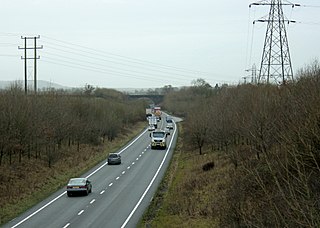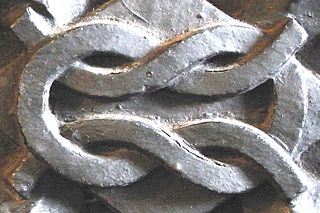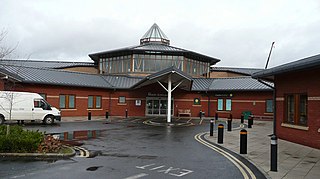Related Research Articles

Mid Devon is a local government district in Devon, England. The council is based in the district's largest town of Tiverton. The district also contains the towns of Bampton, Bradninch, Crediton and Cullompton, along with numerous villages and surrounding rural areas. Part of the district lies within the Blackdown Hills, an Area of Outstanding Natural Beauty.

The A361 is an A class road in southern England, which at 195 miles (314 km) is the longest three-digit A road in the UK.

North Devon is a constituency represented in the House of Commons of the UK Parliament since 2019 by Selaine Saxby of the Conservative Party.

Bampton is a small town and parish in northeast Devon, England, on the River Batherm, a tributary of the River Exe. It is about 6 miles (9.7 km) north of Tiverton, 19 miles (31 km) north of Exeter and the parish borders Somerset on its north-east and north-west sides. Bampton is a major part of the electoral ward of Clare and Shuttern. The ward population at the 2011 Census was 3,412.
Bampton may refer to:

Bampton, also called Bampton-in-the-Bush, is a settlement and civil parish in the Thames Valley about 4+1⁄2 miles (7 km) southwest of Witney in Oxfordshire. The parish includes the hamlet of Weald. The 2011 Census recorded the parish's population as 2,564. Bampton is variously referred to as both a town and a village. The Domesday Book recorded that it was a market town by 1086. It continued as such until the 1890s. It has both a town hall and a village hall.

Oakford is a village and civil parish in the Mid Devon district of Devon, England. It is located three miles (5 km) south west of Bampton and eight miles (13 km) north north west of Tiverton. Oakford is near the river Exe.

Aston is a village about 4 miles (6.4 km) south of Witney in West Oxfordshire, England. The village is part of the civil parish of Aston, Cote, Shifford and Chimney. The southern boundary of the parish is the River Thames. The 2011 Census recorded the parish's population as 1,374.

Bampton Castle in the parish of Bampton, Devon was the seat of the feudal barony of Bampton. It is located on a spur that overlooks the River Batherm.

Stoodleigh is a village and civil parish in the Mid Devon district of Devon, England, located 6 miles (10 km) north of Tiverton and 5 miles (8 km) south of Bampton. It is situated 800 feet (240 m) above the Exe Valley, close to the Devon / Somerset border. The centre of the village is a conservation area.

John Bourchier, 1st Earl of Bath was named Earl of Bath in 1536. He was feudal baron of Bampton in Devon.

Clayhanger is a hamlet and civil parish in the Mid Devon district of Devon, England. At the time of the 2011 census it had a population of 127.

Lew is a village and civil parish about 2+1⁄2 miles (4 km) southwest of Witney in the West Oxfordshire District of Oxfordshire, England. The 2001 Census recorded the parish population as 65. Since 2012 the parish has been part of the Curbridge and Lew joint parish council area, sharing a parish council with the adjacent civil parish of Curbridge.

Shillingford is a village two miles (3 km) northeast of Bampton on the River Batherm in Mid Devon, England, close to the border with West Somerset. It is near the Exe Valley.
Weald is a hamlet in Bampton civil parish in Oxfordshire, England. It lies about 0.7 miles (1.1 km) southwest of Bampton. The toponym Weald is from the Old English for "woodland". The place was recorded by name in the late 12th century when Osney Abbey acquired a house there. It was a separate township by the 13th century. In the 18th and 19th centuries the township included much of the southwest part of the town of Bampton itself. A large late 17th century manor house, Weald Manor, was remodelled at around 1730. It is a Grade II* listed building.

Huntsham is a small village and civil parish, formerly a manor and ecclesiastical parish, in the Mid Devon district of Devon, England. The nearest town is Tiverton, about 5.8 miles (9.3 km) south-west of the village. The parish is surrounded clockwise from the north by the parishes of Bampton, Hockworthy, Uplowman and Tiverton; it is bounded on the east by the River Lowman and by a minor road on Bampton Down to the north west, where it reaches a maximum height of 914 feet (279 m). In 2001 the population of the parish was 138, down from 222 in 1901.

The feudal barony of Bampton was one of eight feudal baronies in Devonshire which existed during the mediaeval era, and had its caput at Bampton Castle within the manor of Bampton.

William Bourchier (1407–1470) jure uxoris 9th Baron FitzWarin, was an English nobleman. He was summoned to Parliament in 1448 as Baron FitzWarin in right of his wife Thomasine Hankford.

The Bourchier knot is a variety of heraldic knot. It was used as a heraldic badge by the Bourchier family, whose earliest prominent ancestor in England was John de Bourchier, a Judge of the Common Pleas, seated at Stanstead Hall in the parish of Halstead, Essex. He was the father of Robert Bourchier, 1st Baron Bourchier (d.1349), Lord Chancellor of England. The various branches of his descendants held the titles Baron Bourchier, Count of Eu, Viscount Bourchier, Earl of Essex, Baron Berners, Baron FitzWarin and Earl of Bath. The knot should perhaps have been called the "FitzWarin knot" as according to Boutell (1864) the device was first used by the FitzWarin family, whose heir was the Bourchier family.

Tiverton and District Hospital is a health facility based in Kennedy Way, Tiverton, Devon, England. It is managed by Royal Devon and Exeter NHS Foundation Trust.
References
- 1 2 "THE HUNDREDS OF DEVON". GENUKI. Retrieved 8 April 2018.